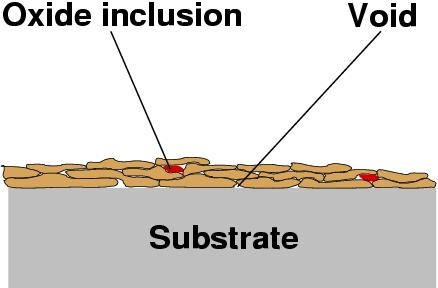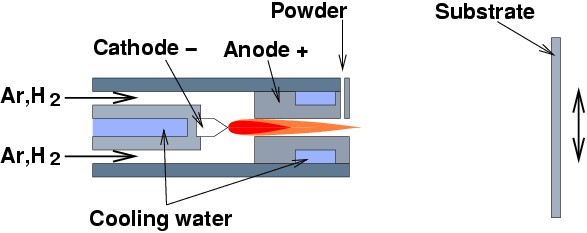
Schematic microstructure of thermal spray coating, showing only a few layers of particles.
| Introduction | Bond Coats | TBC | Processes | Resources | |
| [Introduction] [Thermal Spray] [EBPVD] | Back to phase-transformation home page |
Thermal spraying consists in metling a consumable (most often powder or wire) and project it as molten particles onto the substrate. Upon impact with the substrate, the molten particle flatten and solidify very rapidly. The adhesion is primarily mechanical (for this reason, sprayed MCrAlY coatings are often given a diffusion heat-treatment to obtain good adherence). A sprayed coating will typically include voids (i.e. have some percentage of porosity), and oxide particles. The amount of both depends on the method employed.
All thermal spraying processes are line-of-sight processes, that is to say, only the parts of the component which are directly in the line of the spray are coated.
 |
Schematic microstructure of thermal spray coating, showing only a few layers of particles. |
The adhesion of the coating depends on the cleanliness of the substrate surface, and its area (a high surface roughness is desirable for good adhesion), on the velocity of the particles, etc.
There are various types of thermal spraying methods, some of which are briefly introduced:
A couple of interesting variants of the conventional plasma spraying are known as low pressure plasma spraying (LPPS) and vacuum plasma spray (VPS), which, as indicated by their names, are identical to plasma spraying except for it being done in inert gas at low pressure, or in vacuum. This reduces slowing and cooling the particles by air, and avoids oxidation during spraying. The traditional method is usually referred to as APS (air plasma spray).
 |
Schematic illustration plasma torch. |
APS and LPPS are widely used to apply MCrAlY coatings. TBC can be applied by this method, but it has been shown that the use of EBPVD increases by 7 to 13 times the life of the coating, therefore easily compensating for the higher cost of the latter process. This has been discussed here.
A good part of the above informations comes from:
| conditions of use | 2004 Thomas Sourmail. | Feedback greatly appreciated |